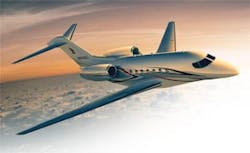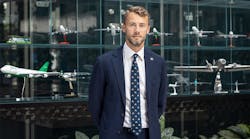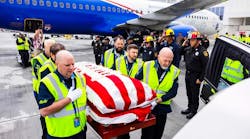If you recently graduated with a fresh A&P certification or are looking for a job with better career opportunities, you need to know what to look for in a prospective employer. Because Cessna Aircraft Company has one of the highest average A&P tenure rates in the industry, AMT decided to talk with its vice president of service facilities, Stan Younger, for advice on maximizing your career choices.
“I don’t intend to brag, but I’m almost a poster child for what you can become with an A&P background,” Younger says. “I walked into Cessna as the lowest grade tech on the shop floor. Now I have three college degrees and Six Sigma certification, all paid for by the company. I head up 10 Citation service centers across the globe. The opportunities are available; the rest is up to your personal goals.”
With the largest business jet fleet in the world, Cessna’s service center network employs about 1,500 people. Approximately 1,150 are A&Ps on the floor, with some avionics techs holding dual certifications. “Almost all of our support staff (another 350 people) carry A&P certification, as well. This includes salespeople, field engineers parts department personnel and managers,” Younger points out.
Retaining good employees
He says the service centers’ A&Ps diagnose and perform mechanical work on Citations, which includes troubleshooting airframes and systems, and repairing engines, components, and flight control systems.
A&Ps also modify and upgrade legacy airplanes.
To retain good A&Ps at Cessna, and what career-seeking technicians should look for, according to Younger, includes:
- A culture that encourages self-esteem — “We don’t just lean on our technicians to be the ‘face’ to the aircraft; we lean on them to be our face to the customer,” he explains. “It’s important for our customers to know that the core technical piece of our business is focused on providing outstanding service. It’s also important for our technicians to understand they’re key to our success.”
He adds, “Our employees get a sense that what they’re doing has purpose. They know our customers purchased their airplanes to fly and not have them in the shop. These customers also take their airplanes to 40,000 feet and fly at ridiculous speeds while they take their most prize possessions — their families and employees — along for the ride. It’s so important that our employees give them the best set of eyes the aviation industry has to offer, and they take pride in that.” - A competitive salary and benefits package — You need to be able to live well in your job’s area. “Most of us have an image of ‘the American dream,” Younger notes. “If you can’t reach that image, it causes family stress. We’ve found when employees are struggling financially, they worry about something other than their work and it shows in their performance and demeanor. Pretty soon the customers feel it, too. That’s why we’re always looking at data to support our pay structure and benefits. We want to be among the top in the industry.”
- A good work environment — You should look for comfortable facilities where you can be efficient at your tasks. “If you have to fight a substandard facility, it makes you struggle to serve customers,” Younger points out.
Related to this is the facility’s location. “Most of our centers are in ‘cool’ cities with unique personalities,” he says. “This provides us an ability to draw the best people from the region.”
Another facet of a good work environment is not having to struggle between right and wrong. “We have no time for people who skirt the industry regulations; we don’t stand for anyone forcing a tech to turn his/her head and passing over something that is not correct,” he emphasizes. “Look for a place where there is no pressure to perform substandard work in order to keep your job.” - Diversity — A facility where there are both genders, a broad range of backgrounds and several generations working together is more fun and stimulating, according to Younger. “Our workforce has cultural diversity and it spans three generations of Baby Boomers, Generation X’ers and Millennials. I think it makes us a better company,” he notes. “We recognize their different needs and must be doing something right to meet them; everywhere throughout our company you can see engaged employees working side-by-side with people of various ages, races, and genders.”
Citation Service Centers Cessna’s 10 Citation service centers that Stan Younger is in charge of are located in:
|
Ask questions
Younger wishes aviation schools would offer classes in interviewing skills and teach graduates to ask the right questions. Here are some he thinks job seekers should ask:
- Will I come to work in a place that is safe and healthy? — “Look at the company’s safety record,” he advises, “and check out the facilities when they give you a tour. You can probably tell if the employees are in a safe environment and their health is a priority.”
- Will this company develop me as an individual and see me as a contributor to the company’s and customers’ success? — “It’s all about training,” he explains. “You need a wide range of capabilities to be a well-rounded employee. Will this employer help you get there?”
He emphasizes that Cessna makes sure everyone has the technical skills they need to do their job, and trains accordingly. (The company provides 77,500 training hours yearly, a substantial investment.) But the firm also provides opportunities for cultural training, Skill Port (in-house, online system) training modules in things like the Foreign Corrupt Practices Act, Six Sigma training, and more.
“Once you’re hired, you can go lots of directions to make yourself happy; it’s up to the individual. Our managers mentor the staff, too,” he says. “Cessna now helps pay for acquiring a second language, for example. We think that’s important as many of our new aircraft go abroad and this offers job opportunities.” - Can I fit in? — This goes to a feeling of belonging, and it’s important, Younger says. “We try to give our people something they can participate in that makes them feel like part of the Cessna family,” he notes. “This also relates to self-esteem and having a positive outlook that is evident to us and our customers.”
- Will I interact with the customers? — “We consider it on-the-job training whenever our A&Ps talk with customers,” he explains. “Every time they communicate with a customer they learn another aspect of the job.”
Cessna looks for people with an entrepreneurial spirit. It seeks those who look at their jobs as if they were owners and are ready to do whatever is needed to satisfy customer needs. “If this describes you, you won’t feel comfortable working in a place that never lets you make an independent decision or directly solve a customer’s problem,” he notes.
“Cessna is not only the world’s largest manufacturer of general aviation airplanes, it’s a great place to work,” Younger concludes. “Being a member of the Cessna family has been one of the best decisions I’ve ever made.”



